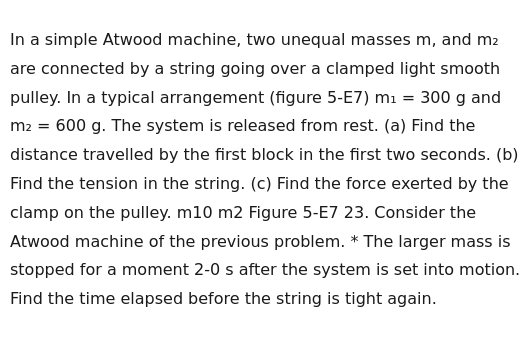Question
Question: In a simple Atwood machine, two unequal masses m, and m₂ are connected by a string going over a clam...
In a simple Atwood machine, two unequal masses m, and m₂ are connected by a string going over a clamped light smooth pulley. In a typical arrangement (figure 5-E7) m₁ = 300 g and m₂ = 600 g. The system is released from rest. (a) Find the distance travelled by the first block in the first two seconds. (b) Find the tension in the string. (c) Find the force exerted by the clamp on the pulley. m10 m2 Figure 5-E7 23. Consider the Atwood machine of the previous problem. * The larger mass is stopped for a moment 2-0 s after the system is set into motion. Find the time elapsed before the string is tight again.

(a) The first block travels approximately 6.53m in 2 seconds.
(b) The tension in the string is approximately 3.92N.
(c) The force exerted by the clamp on the pulley is approximately 7.84N.
(d) Once m2 is stopped at 2.0 s, the string becomes tight again after about 1.34s.
Solution
We solve the problem step‐by‐step.
Step 1. Find the acceleration
For an Atwood machine the acceleration is
a=m1+m2(m2−m1)gwith
m1=0.3kg,m2=0.6kg,g=9.8m/s2.Thus
a=0.3+0.6(0.6−0.3)×9.8=0.90.3×9.8≈3.27m/s2.Step 2. (a) Distance travelled by the first block in 2.0 s
Starting from rest with constant acceleration,
s=21at2=21×3.27×(2)2≈6.53m.Step 3. (b) Tension in the string
Take mass m1 (which moves upward) and write Newton’s 2nd law:
T−m1g=m1a⟹T=m1(g+a).So
T=0.3(9.8+3.27)=0.3×13.07≈3.92N.(One may check using m2:
m2g−T=m2a⇒T=m2(g−a)=0.6(9.8−3.27)≈3.92N.)Step 4. (c) Force exerted by the clamp on the pulley
The light, smooth pulley is acted on by the two string tensions. In a standard Atwood machine the rope contacts the pulley over a semicircular arc. A standard result is that the net force on the pulley (which must be balanced by the clamp) is
Fclamp=2T⟹Fclamp≈2×3.92=7.84N.Step 5. (d) Time for the string to become tight again when m2 (the larger mass) is stopped at t=2.0 s
At t=2.0s:
- Both masses have reached speeds ∣v∣=a×2≈6.53m/s (with m1 moving upward and m2 downward).
- The string is just taut.
Now suppose at t=2.0s the larger mass m2 is suddenly held fixed while m1 continues upward. Immediately, m1 has speed 6.53m/s upward and will continue its motion as a free projectile (ignoring the now‐slack string) under gravity alone.
-
Extra upward travel:
0=v2−2gΔh⟹Δh=2gv2=2×9.8(6.53)2≈19.642.67≈2.18m.
The additional height Δh gained by m1 is found fromThis extra travel creates a slack of 2.18m in the string on the m1 side.
-
Time to re‐take up the slack:
2.18=21gtfall2⟹tfall=9.82×2.18≈0.444≈0.67s.
At the top, m1 has zero speed. It then falls a distance 2.18m under gravity. The time tfall to fall that distance is given by -
Also, the time to reach the maximum height (from t=2.0s) is
tup=9.86.53≈0.67s.
Thus the total time from t=2.0s until the string becomes taut again is
tslack=tup+tfall≈0.67+0.67=1.34s.